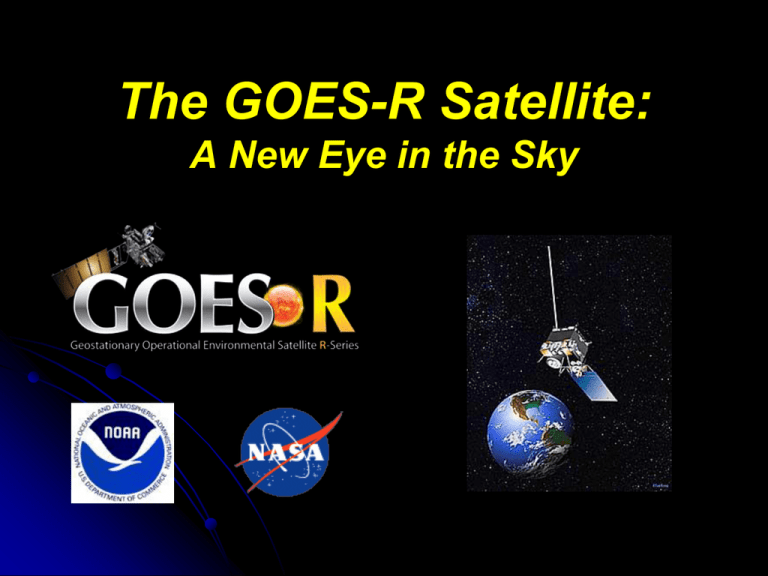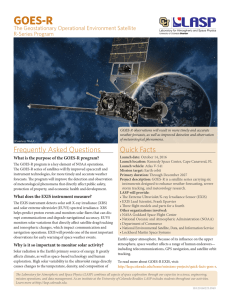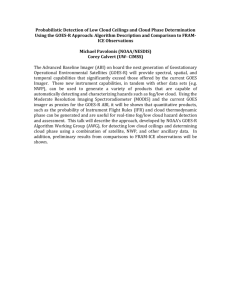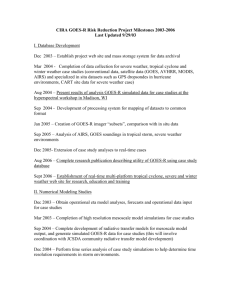The GOES-R Satellite: A New Eye in the Sky
advertisement

The GOES-R Satellite: A New Eye in the Sky GOES Satellite “R” series Under development since late 1990s Next in progression of GOES satellite series ENORMOUS increase of data Replacing the GOES N/O/P (13/14/15) satellites as they end their scheduled orbital lifespan Improvements in spatial, spectral, temporal and radiometric resolution of products New technology for new products Continuity of GOES Operational Satellite Program Scheduled Launch January-March 2016 GOES-R Milestones GOES-R Instruments Advanced Baseline Imager (ABI) 16 Channel imager Improves upon current satellite capabilities 2 visible, 4 near-IR and 10 IR channels 3 times spectral information 4 times spatial coverage 5 times temporal resolution Continues current products Allows for new products Severe weather forecasting Fire and smoke monitoring Volcanic Ash Advisories Visible and Infrared Imagery Full Disk every 15 minutes CONUS every 5 minutes Rapid Scan every minute Super Rapid Scan – 1000 km² every 30 seconds OR 2 areas per minute! Progression of GOES Fog Products Heritage GOES Fog Detection GOES-R Algorithm applied to current GOES GOES-R Algorithm Applied to GOES-R ** ** Using data from TERRA, AQUA and GOES, part of GOES-R Proving Ground GOES-R Products Sample Baseline Products Aerosols Clouds and Moisture Imagery Fire Detection & Characterization (FDC) Hurricane Intensity Estimation Hydrology Snow Cover Volcanic Ash: Detection & Height Future Capability Products Aircraft Icing Threat Enhanced-V & Overshooting Top Estimation Flood/Standing Water Fog/Low Cloud Detection Turbulence Visibility http://www.goes-r.gov/products/ list.html www.swpc.noaa.gov GOES-R Space Weather Space Environment In-Situ Suite (SEISS) • Ensemble of electron, proton and heavy ion detection sensors • Critical information to assess electrostatic discharge risk & radiation hazard to astronauts and satellites • Warn of high flux events, mitigate any damage to radio communication • Data will drive solar radiation storm portion of NOAA Space Weather Scales • Geomagnetic storms • Solar Radiation storms • Radio Blackouts www.swpc.noaa.gov/NOAAscales GOES-R Space Weather Extreme UV/X-ray Irradiance Sensor (EXIS) • Solar X-ray irradiance (XRS) & Solar Extreme UV (EUVS) spectral irradiance in 5-127 nm range • Issue warnings based on solar x-ray increases, large spikes from solar flares • Warnings for radio blackouts of terrestrial HF radio communications at low latitudes • Potential hazards to astronauts in orbit, decrease in optimal life of satellites (degradation of solar panels) Current SWPC Irradiance product New capabilities expected with new data from GOES-R GOES-R Space Weather Solar UV Imager (SUVI) Locates coronal holes, flares and coronal mass ejection source regions Characterizes active region complexity Improves forecasting of space weather and early warnings of possible Earth environmental impacts Magnetometer Measures time-varying field in magnetosphere Provides only operational measure of impact of geomagnetic storms at geosynchronous orbit Key in interpreting solar radiation storm measurements by SEISS www.goes-r.gov/users/proving-ground Formal GOES-R Proving Ground Partners May 2014 http://cimss.ssec.wisc.edu/goes_r/proving-ground.html NOAA’s Hazardous Weather Testbed Not just a facility… …but an organization Testbed Takeaways – 2014 Almost ready for operations ProbSevere Trends on target Struggles with mature cells NearCast Predicted area of convective instability well Possibly add an interpolation toggle ability to fill gaps in with NWP Testbed Takeaways – 2014 Get this to my office “yesterday”! Lightning Flashes & Lightning Jump Algorithm Increases confidence in severity of storms Provided information about updraft health Super-Rapid Scan Operations (SRSOR) Imagery Used to observe key storm-scale features; 1-min temporal resolution made this possible Simulated Satellite Imagery Comparison to reality raised or lowered confidence in using model When on-track, predicted areas of storm development Training and Education Materials New! Online Training Modules • How Satellite Observations Impact NWP • GOES-R ABI: Next Generation Satellite Imaging (COMET) • GOES-R: Benefits of Next-Generation Environmental Monitoring (COMET) • Satellite Hydrology and Meteorology for Forecasters (SHyMet) • SPoRT product training modules • VISIT Training Resources • Commerce Learning Center Printed Materials • GOES-R Fact Sheets (18) • User Readiness Plan • GRB Downlink Specifications and Product Users Guide • Proving Ground Demonstration Final Reports and Annual Reports Also Available: • Student Resources • “Fun and Games” http://www.goes-r.gov/education/outreach.html



